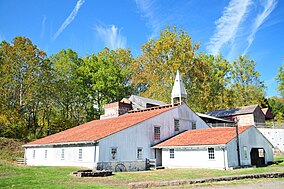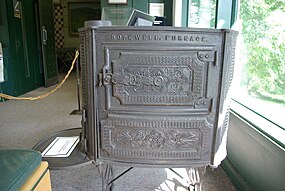
Birdsboro is a borough in Berks County, Pennsylvania, United States. It is located along the Schuylkill River 8 miles (13 km) southeast of Reading. As of the 2010 census, it had a population of 5,163. Birdsboro's economy had historically been rooted in large foundries and machine shops, none of which remain in operation today.
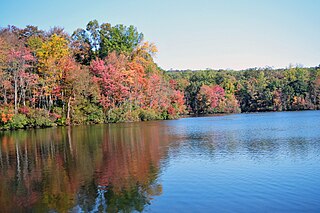
French Creek State Park is a 7,977-acre (3,228 ha) Pennsylvania state park in North Coventry and Warwick Townships in Chester County and Robeson and Union Townships in Berks County, Pennsylvania. It straddles northern Chester County and southern Berks County along French Creek. It is located in the Hopewell Big Woods. The park is the home of two lakes: Hopewell Lake, a 68-acre (28 ha) warm water lake, and Scotts Run Lake, a 22-acre (8.9 ha) cold water lake. The state record smallmouth bass was caught in Scotts Run Lake. There are extensive forests, and almost 40 miles (64 km) of hiking and equestrian trails. The park is also friendly to mountain bikers, having some renowned technical trails. Hopewell Furnace National Historic Site, which features a cold blast furnace restored to its 1830s appearance, is surrounded by the park. The Six Penny Day Use Area and Group Camp are listed on the National Register of Historic Places. French Creek State Park is located off of Pennsylvania Route 345 to the south of Birdsboro.
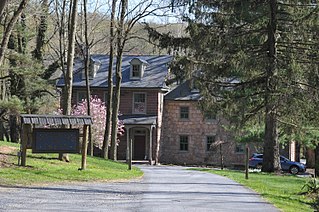
Speedwell Forge Mansion, also known as Speedwell Forge Homestead, is a historic home located at Elizabeth Township, Lancaster County, Pennsylvania. The ironmaster's mansion was built about 1760, and is a 2½-story, four bay wide and two bay deep, brownstone and fieldstone dwelling in the Georgian style. It was expanded about 1795 with a Georgian/Federal style wing. Also on the property are a contributing stone summer kitchen, stone and frame workshop, stone paymaster's office c. 1795), and stone privy.

The Tannehill Ironworks is the central feature of Tannehill Ironworks Historical State Park near the unincorporated town of McCalla in Tuscaloosa County, Alabama. Listed on the National Register of Historic Places as Tannehill Furnace, it was a major supplier of iron for Confederate ordnance. Remains of the old furnaces are located 12 miles (19 km) south of Bessemer off Interstate 59/Interstate 20 near the southern end of the Appalachian Mountains. The 2,063-acre (835 ha) park includes: the John Wesley Hall Grist Mill; the May Plantation Cotton Gin House; and the Iron & Steel Museum of Alabama.

Iron plantations were rural localities emergent in the late-18th century and predominant in the early-19th century that specialized in the production of pig iron and bar iron from crude iron ore.
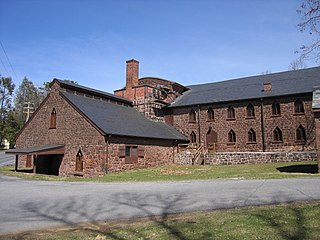
Cornwall Iron Furnace is a designated National Historic Landmark that is administered by the Pennsylvania Historical and Museum Commission in Cornwall, Lebanon County, Pennsylvania in the United States. The furnace was a leading Pennsylvania iron producer from 1742 until it was shut down in 1883. The furnaces, support buildings and surrounding community have been preserved as a historical site and museum, providing a glimpse into Lebanon County's industrial past. The site is the only intact charcoal-burning iron blast furnace in its original plantation in the western hemisphere. Established by Peter Grubb in 1742, Cornwall Furnace was operated during the Revolution by his sons Curtis and Peter Jr. who were major arms providers to George Washington. Robert Coleman acquired Cornwall Furnace after the Revolution and became Pennsylvania's first millionaire. Ownership of the furnace and its surroundings was transferred to the Commonwealth of Pennsylvania in 1932.

The Coventryville Historic District is a historic district and historic village in Chester County, Pennsylvania, United States that enjoyed a significant role in the early American metal industry.
The Ghost Town Trail is a rail trail in Western Pennsylvania that runs 36 miles (58 km) between Black Lick, Indiana County, and Ebensburg, Cambria County. Established in 1991 on the right-of-way of the former Ebensburg and Black Lick Railroad, the trail follows the Blacklick Creek and passes through many ghost towns that were abandoned in the early 1900s with the decline of the local coal mining industry. Open year-round to cycling, hiking, and cross-country skiing, the trail is designated a National Recreation Trail by the United States Department of the Interior.
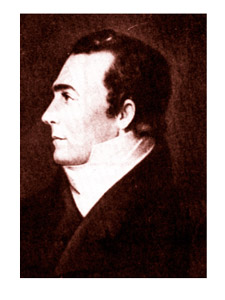
Henry Bates Grubb was a third-generation member of the Grubb Family Iron Dynasty, the founder of the family's enterprises headquartered at Mount Hope near Lancaster, Pennsylvania, and perhaps the family's first "true" ironmaster. He was the son and heir of Peter Grubb, Jr. who, with his brother Curtis, had owned and operated the Cornwall ironworks founded by their father Peter Grubb in 1737. Henry and his heirs rebuilt the family business after most of the original Peter Grubb holdings were gradually acquired by Robert Coleman between 1783 and 1802. The Grubbs and Colemans were among the largest iron producers in Pennsylvania through the mid-19th century.
The Grubb Family Iron Dynasty was a succession of iron manufacturing enterprises owned and operated by Grubb family members for more than 165 years. Collectively, they were Pennsylvania's leading iron manufacturer between 1840 and 1870.

Isabella Furnace was a cold blast charcoal iron furnace located in West Nantmeal Township, Pennsylvania. The furnace was named for Isabella Potts, wife of one of the partners, a member of the Potts ironmaking family. Isabella was the last iron furnace to be built in the county, in 1835, and was operated by members of the Potts family and their partners until 1855, when they lost control of it in a bankruptcy. It returned to the family in 1881, when it was purchased by Col. Joseph Potts, who modernized it. The furnace, the last to operate in Chester County, went out of blast in 1894, a few months after Col. Potts' death, but remained largely intact until after his son's death in 1943. The remains of the furnace complex have been listed in the National Register of Historic Places since 1991.
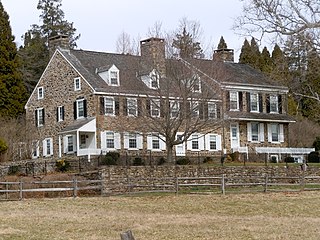
The Warwick Furnace Farms is a historic district that is located in northern Chester County, Pennsylvania, United States that includes the ruins of an early iron furnace that was owned by Anna Rutter Nutt, widow of Samuel Nutt.

The Joanna Furnace Complex was an iron furnace that operated from 1792 to 1901 in Robeson Township, Berks County, Pennsylvania. It was founded by Samuel Potts and Thomas Rutter III and named for Potts's wife Joanna.
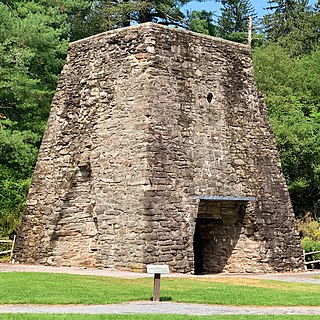
The Pine Grove Iron Works was a smelting facility in southcentral Pennsylvania during the Industrial Revolution. The works is notable for remaining structures that are historical visitor attractions of Pine Grove Furnace State Park, including the furnace stack of the Pine Grove Furnace. The site was listed on the National Register of Historic Places on April 13, 1977 for its significance in architecture and industry. It includes seven contributing buildings, two structures, fourteen sites, and two objects.

The Swatara Furnace is a historic iron furnace and 200-acre national historic district located along Mill Creek, a tributary of the Swatara Creek in Pine Grove Township, Schuylkill County, Pennsylvania.
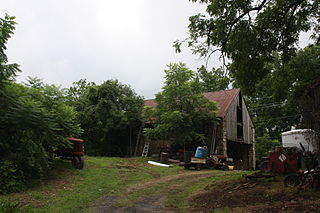
Dale Furnace and Forge Historic District, also known as Dale Iron Works and Mt. Chalfont Furnace, is a historic "iron plantation" and national historic district located in Washington Township, Berks County, Pennsylvania. The district encompasses six contributing buildings and one contributing site. They are a stone horse barn, stone and frame bank barn, ironmaster's mansion, smokehouse and wash house (1827), stone worker's house (1830), and counting house. The archaeological site includes the ruins of a worker's house, the stone furnace stack, bank iron furnace, forge foundations and race, and remnants of dam breast. The furnace remained in blast until about 1822, and the Dale Forge was in operation until 1868.

The Hopewell Big Woods is the largest contiguous forest in southeastern Pennsylvania. Spanning northern Chester County and southern Berks County, the region is approximately 73,000 acres or 114 square miles. Most of the forest is located in the Schuylkill River watershed.

The Edward Brooke II Mansion (1887–88), also known as "Brookeholm," is a Queen Anne country house at 301 Washington Street in Birdsboro, Pennsylvania. Designed by architect Frank Furness and completed in 1888, it was Edward Brooke II's wedding present to his bride, Anne Louise Clingan.
Martha Furnace is an abandoned iron furnace in Burlington County, New Jersey, in the New Jersey Pine Barrens. It operated between 1793 and the mid-1840s, using charcoal fuel and locally-mined bog iron to make a variety of cast products as well as pig iron. For most of its operating history, it was principally owned by the New Jersey ironmaster Samuel Richards and managed by Jesse Evans. The settlement that grew up around it was abandoned after ironmaking ceased, and the site of the furnace now lies undeveloped in Wharton State Forest.

Thomas Rutter was an American ironmaster and abolitionist who constructed the first blast furnace and the first iron forge in the Province of Pennsylvania. Now known as Pine Forge Mansion and Industrial Site, the location of Rutter's mansion and iron plantation was listed on the National Register of Historic Places in 2004. The site has been the campus of Pine Forge Academy since 1945.
